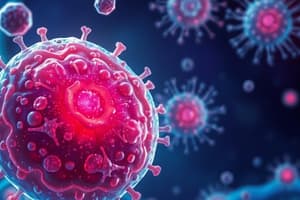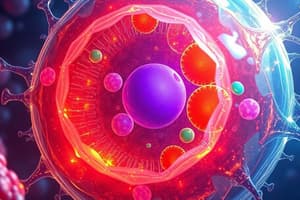Podcast
Questions and Answers
What is the primary function of mitochondria in a cell?
What is the primary function of mitochondria in a cell?
- Photosynthesis
- Genetic material storage
- Protein synthesis
- ATP production (correct)
Which structure is responsible for regulating the entry and exit of substances in a cell?
Which structure is responsible for regulating the entry and exit of substances in a cell?
- Cell Membrane (correct)
- Nucleus
- Ribosomes
- Golgi Apparatus
Which of the following statements about eukaryotic and prokaryotic cells is true?
Which of the following statements about eukaryotic and prokaryotic cells is true?
- Prokaryotic cells do not have a nucleus. (correct)
- Eukaryotic cells are smaller and simpler than prokaryotic cells.
- Eukaryotic cells lack a cell membrane.
- Prokaryotic cells contain membrane-bound organelles.
What is the primary role of ribosomes within the cell?
What is the primary role of ribosomes within the cell?
Which mechanism explains how species adapt and change over time?
Which mechanism explains how species adapt and change over time?
What evidence supports the theory of evolution through comparative anatomy?
What evidence supports the theory of evolution through comparative anatomy?
Which process results in the production of gametes with half the chromosome number?
Which process results in the production of gametes with half the chromosome number?
What does the fossil record provide evidence for in evolutionary biology?
What does the fossil record provide evidence for in evolutionary biology?
Flashcards are hidden until you start studying
Study Notes
Cell Biology
-
Basic Unit of Life: Cells are the fundamental structural and functional units of all living organisms.
-
Types of Cells:
- Prokaryotic Cells: Lack a nucleus; smaller and simpler (e.g., bacteria).
- Eukaryotic Cells: Have a nucleus; larger and more complex (e.g., plant and animal cells).
-
Cell Structure:
- Cell Membrane: Semi-permeable barrier; regulates the entry and exit of substances.
- Nucleus: Contains genetic material (DNA); controls cell activities.
- Cytoplasm: Jelly-like substance where cellular processes occur; contains organelles.
- Organelles:
- Mitochondria: Powerhouse of the cell; site of ATP production.
- Ribosomes: Protein synthesis.
- Endoplasmic Reticulum:
- Rough ER: Studded with ribosomes; involved in protein synthesis.
- Smooth ER: Lacks ribosomes; lipid synthesis and detoxification.
- Golgi Apparatus: Modifies, sorts, and packages proteins and lipids for secretion.
- Lysosomes: Contain digestive enzymes for waste breakdown.
- Chloroplasts: Site of photosynthesis in plant cells; contain chlorophyll.
-
Cell Division:
- Mitosis: Process of cell division resulting in two identical daughter cells (for growth and repair).
- Meiosis: Specialized cell division producing gametes with half the chromosome number (for reproduction).
Evolutionary Biology
-
Theory of Evolution: Explains how species change over time through natural selection and adaptation.
-
Natural Selection:
- Mechanism by which individuals with favorable traits are more likely to survive and reproduce.
- Key components:
- Variation: Differences in traits among individuals.
- Inheritance: Traits must be heritable.
- Differential Survival: Some variations increase chances of survival and reproduction.
-
Evidence for Evolution:
- Fossil Record: Shows changes in species over time and transitional forms.
- Comparative Anatomy: Homologous structures indicate common ancestry, while analogous structures show convergent evolution.
- Molecular Biology: Similar DNA sequences among related species support evolutionary relationships.
-
Speciation: Process by which new species arise, often due to geographic isolation or environmental changes.
-
Evolutionary Trees: Diagrams that represent evolutionary relationships among species, illustrating common ancestors.
-
Adaptation: Features that enhance survival and reproduction in specific environments; can be structural, behavioral, or physiological.
Cell Biology
- Cells serve as the basic structural and functional units of living organisms.
- Prokaryotic cells are characterized by the absence of a nucleus; examples include bacteria, which are smaller and simpler than eukaryotic cells.
- Eukaryotic cells possess a nucleus, allowing for more complex structures; examples include plant and animal cells.
- The cell membrane acts as a semi-permeable barrier, controlling the movement of substances in and out of the cell.
- The nucleus houses genetic material (DNA) and regulates cellular activities.
- Cytoplasm is a jelly-like substance where metabolic processes take place and organelles are suspended.
- Mitochondria are known as the powerhouse of the cell, responsible for ATP production through cellular respiration.
- Ribosomes are essential for the synthesis of proteins, either free-floating in the cytoplasm or attached to the endoplasmic reticulum.
- The endoplasmic reticulum (ER) has two forms:
- Rough ER has ribosomes and is involved in protein synthesis.
- Smooth ER lacks ribosomes and focuses on lipid synthesis and detoxifying harmful substances.
- The Golgi apparatus performs modification, sorting, and packaging of proteins and lipids for secretion or delivery to other organelles.
- Lysosomes contain digestive enzymes that break down waste materials and cellular debris.
- Chloroplasts are found in plant cells, responsible for photosynthesis, and contain chlorophyll for capturing light energy.
- Mitosis is a type of cell division that results in two genetically identical daughter cells, vital for growth and tissue repair.
- Meiosis produces gametes with half the chromosome number, crucial for sexual reproduction.
Evolutionary Biology
- The theory of evolution describes how species change over time through mechanisms such as natural selection and adaptation.
- Natural selection favors individuals with beneficial traits, thereby enhancing their chances of survival and reproduction.
- Key components of natural selection include:
- Variation: Differences in traits among individuals in a population.
- Inheritance: The ability for beneficial traits to be passed down to offspring.
- Differential survival: Certain variations improve survival and reproductive success.
- The fossil record provides evidence of how species have evolved over time, showcasing transitional forms.
- Comparative anatomy reveals homologous structures, which suggest common descent, and analogous structures that result from convergent evolution.
- Molecular biology indicates evolutionary relationships through similarities in DNA sequences across related species.
- Speciation occurs when new species develop, often due to geographic isolation or changes in the environment.
- Evolutionary trees illustrate the relationships among different species, highlighting common ancestors.
- Adaptation encompasses traits that enhance survival and reproduction in specific environments, including structural, behavioral, and physiological changes.
Studying That Suits You
Use AI to generate personalized quizzes and flashcards to suit your learning preferences.




